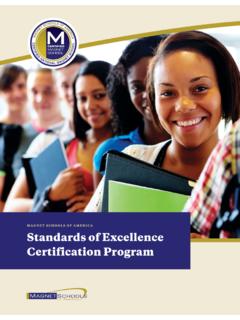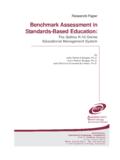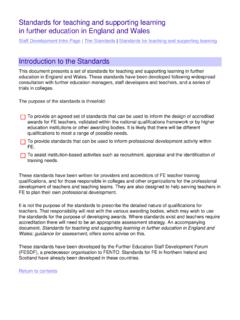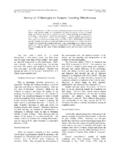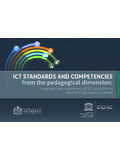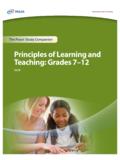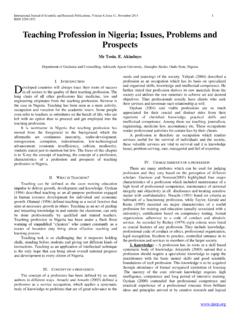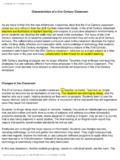Transcription of SELECTING TEXTS FOR TEACHING AND ... - Odell …
1 SELECTING TEXTS . FOR TEACHING AND ASSESSING. CCSS ELA READING standards . GRADES 3-12. TABLE OF CONTENTS. I. TEXT COMPLEXITY .. 4. A. QUALITATIVE MEASURES OF TEXT COMPLEXITY .. 4. 1) Levels of Purpose/Meaning ..5. 2) Structure ..5. 3) Language Conventiality and Clarity ..6. 4) Knowledge Demands ..6. B. QUANTITATIVE MEASURES OF TEXT COMPLEXITY .. 7. Common Scale for Band Level Text Difficulty Ranges ..7. II. INFORMATIONAL TEXT TYPES .. 8. III. TEXT SUITABILITY FOR SPECIFIC 9. A. TEXT CHARACTERISTICS FOR TEACHING AND ASSESSING INDIVIDUAL standards .. 9..9.. 10.. 12.. 13.. 14.. 16.. 17.. 19.. 20. B. TEXT CHARACTERISTICS FOR TEACHING AND ASSESSING BUNDLED standards .. 22. Informational Text Bundles .. 22. Bundle 1: Expository Passage .. 22. Bundle 2: Argumentative Passage .. 22. Bundle 3: Paired Narrative Passages .. 23. Bundle 4: Paired Argumentative Passages .. 23. Bundle 5: Paired Multi-media Argumentative Passages .. 24. Bundle 6: Paired Multi-media Narrative Passages .. 24. Literary Text Bundles.
2 25. Bundle 1: Poem .. 25. Bundle 2: Narrative Fiction Passage .. 25. Bundle 3: Paired Narrative Fiction Passages .. 25. Bundle 4: Paired Multi-media Passages .. 26. 2. INTRODUCTION. Successful implementation of the Common Core State standards (CCSS) rests on the development of well- aligned instructional materials, formative and summative assessments, and teacher training. The CCSS. represent some shifts in emphasis with direct implications for development of these materials. In particular the CCSS devote considerable attention to the types and nature of TEXTS used in instruction and assessment. The foundation for preparing students for the linguistic rigors of college, the workplace, the military, and civic life lies in the TEXTS with which they interact. By the time they graduate, students should be prepared to independently read and analyze the types of complex TEXTS they will encounter after high school. SELECTING TEXTS of appropriate type and complexity for use in instruction and assessment is integral to this preparation.
3 One of the major shifts of the CCSS is an emphasis on developing skills for comprehending and analyzing informational TEXTS . Increased exposure to informational TEXTS better prepares students for the various types of TEXTS they will encounter after graduation. The array of TEXTS selected for instruction and assessment from K-12 should support the development of the necessary skills to handle this range of informational TEXTS . Another shift is an increased emphasis on the analysis across multiple TEXTS , often of varied genres and media. Several standards , especially for reading literature require intertextual and multi-media analysis. These expectations require special attention to selection of related TEXTS , chosen specifically to support instruction and assessment of the full range of expectations. It will also require careful consideration of which standards are appropriate for large-scale assessment formats and how those assessments might be modified to include TEXTS of a variety of media.
4 In addition to the usual content, fairness, and sensitivity guidelines, when SELECTING TEXTS , attention should be dedicated to three additional considerations: Text Complexity Text Types Text Suitability for Specific standards This document offers guidelines for SELECTING TEXTS regarding these three considerations. These guidelines should inform the training of passage finders in order to ensure a pool of acceptable TEXTS that can support instruction and assessment of all the CCSS Reading standards . They should also inform curriculum and assessment developers as they construct yearlong instruction and assessment plans to cover the complete range of skills. These guidelines can be used in concert with the Text Suitability Review Form. The Review Form provides educators a way to structure and capture analysis of TEXTS for archiving and sharing with their development teams. Click here to download the Review Form for free 3. I. TEXT COMPLEXITY. SELECTING TEXTS of appropriate complexity is essential for TEACHING and assessing the comprehension skills at each developmental level.
5 Passages too basic for a given level will not possess the necessary vocabulary, syntax, structures, and content development to develop the grade-level skills. Passages too complex for a given level will contain characteristics that interfere with the development of the grade-level skills. Text complexity is generally determined using quantitative and qualitative measures. A. QUALITATIVE MEASURES. OF TEXT COMPLEXITY. Qualitative measurement of TEXTS is analysis based on the judgment of a skilled professional. Text finders should analyze potential TEXTS to determine if they are of suitable complexity for developing specific grade- level CCSS expectations. Appendix A of the CCSS highlights important textual characteristics for measuring text complexity 1: 1. Levels of Purpose/Meaning 2. Structure 3. Language Conventiality and Clarity 4. Knowledge Demands These characteristics should structure the analysis of potential TEXTS . Attention to them is essential for both determining a text's complexity, as well as its suitability for assessing certain standards .
6 The following questions should be answered when determining a potential text's complexity and suitability for use. 1. Common Core State standards for English Language Arts and Literacy in History/Social Studies, Science, and Technical Subjects Appendix A: Research Supporting Key Elements of the standards and Glossary of Terms. 4. 1. LEVELS OF PURPOSE/MEANING. INFORMATIONAL TEXTS . Guiding Questions: What is the main purpose of the text? Are there multiple purposes? Are the purposes explicit or implicit? What knowledge is required to determine and understand the text's purpose(s)? Can a passage be extracted that maintains the text's purposes in tact? Passages with multiple and implied purposes tend to be of higher complexity. Close attention should be paid to the nature of the purposes as well. At the K-4 levels, basic clear singular purposes are appropriate. TEXTS like speeches, correspondence and op-ed pieces can have a rich layering of purposes that will support the instruction and assessment of standards for analysis of both content and craft at grades 5-12.
7 LITERARY TEXTS . Guiding Questions: What are the main themes of the text? Are the meanings literal/figurative/ambiguous? What knowledge is required to determine and understand the text's meanings? Can a passage be extracted that maintains the text's meanings intact? Passages with multiple levels of meaning tend to be of higher complexity. Close attention should be paid to the nature of the meanings as well. Complexity increases as meaning relies more on figurative language and is purposely ambiguous. 2. STRUCTURE. INFORMATIONAL TEXTS . Guiding Questions: What is the organizational structure of the text? Does the structure conform to common genres or to a specialized discipline? Is the structure clearly marked with text features? How extended is the development of the ideas/argumentation? How complex are the graphics of the text? Do graphics present new independent information necessary for comprehension of the full text? The organizational structure of a potential passage should be carefully outlined to determine the complexity of its ideas and argumentation.
8 Starting with grade 6, passages must have exposition or argumentation that develop across multiple paragraphs and contains a number of supporting details or claims. 5. LITERARY TEXTS . Guiding Questions: What is the organizational structure of the text? Does the structure conform to common genres? Is the structure clearly marked with text features? Is the narrative structure chronological or does sequencing move back and forth in time? Is the narrative structured with a single or multiple points of view? How do events develop and move from one to the next? The narrative structure of a potential passage should be analyzed to determine its sequencing and point of view. TEXTS generally increase in complexity as their structures deviate from basic chronological narration. Multiple points of view and subtle transitions built primarily on dialogue can make TEXTS more complex as well. 3. LANGUAGE CONVENTIALITY AND CLARITY. INFORMATIONAL AND LITERARY TEXTS . Guiding Questions: Are literal or figurative meanings of the language generally used?
9 Are meanings of words and sections clear or intentionally ambiguous? Is the language archaic or discipline-specific? Is the diction conversational, academic, or esoteric? 4. KNOWLEDGE DEMANDS. INFORMATIONAL AND LITERARY TEXTS . TEXTS suitable for assessing reading comprehension must be sufficiently self-contained in their knowledge demands. TEXTS that rely too much on the life-experience and prior-knowledge of a specific discipline will not suitable. This is especially true for argumentative TEXTS . Extra attention should be paid when SELECTING argumentative TEXTS to make sure their contexts are clear and explicitly given within the passages. 6. B. QUANTITATIVE MEASURES. OF TEXT COMPLEXITY. Quantitative measures rely predominantly on word frequency ratings and sentence length with some scales incorporating additional characteristics like punctuation, word meaning and syntactical features, and sentence and paragraph cohesion. Nelson, Perfetti, Liben, and Liben's recent study, Measures of Text Difficulty: Testing their Predictive Value for Grade Levels and Student Performance, represents the most thorough analysis of quantitative text complexity measures to date 2.
10 Using the study, they developed a common scale for band level text difficulty ranges. When quantitative measures are available, this scale should guide passage selection for particular grade levels. Common Scale for Band Level Text Difficulty Ranges TEXT ANALYZER TOOL. CCSS Band ATOS DRP FK LEXILE SR RM. 2 -3. nd rd 42-54 420-820 4th-5th 52-60 740-1010 6th-8th 57-67 925-1185 9th-10th 62-72 1050-1335 11th-CCR 67-74 1185-1385 Key ATOS ATOS (Renaissance Learning). DRP Degrees of Reading Power (Questar). FK Flesch-Kincaid . LEXILE Lexile Framework (MetaMetrics). SR Source Rater (Educational Testing Service). RM Pearson Reading Maturity Metric (Pearson Education). 2. Nelson, Jessica; Perfetti, Charles; Liben, David; and Liben, Meredith, Measures of Text Difficulty: Testing their Predictive Value for Grade Levels and Student Performance, 2012. 7. II. INFORMATIONAL TEXT TYPES. Informational TEXTS come in a variety of forms, each with its own unique purposes and structures. Each of these types has unique characteristics, but they can be grouped by general similarities in structure and purpose.
